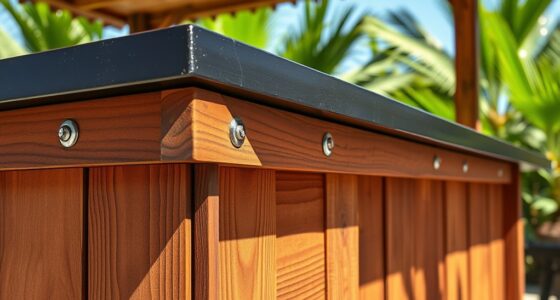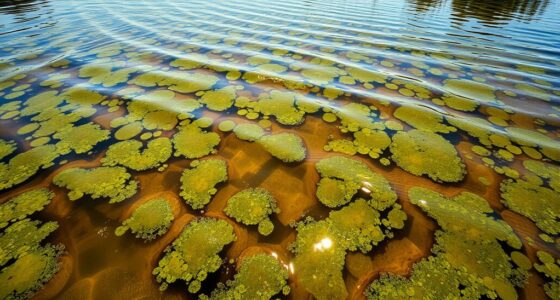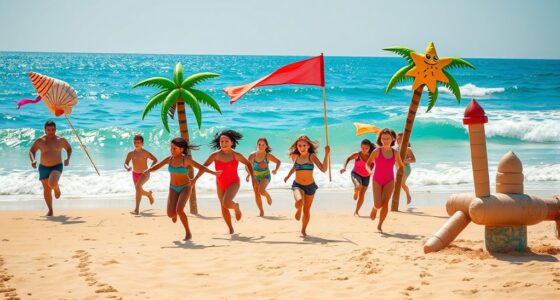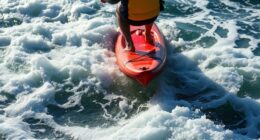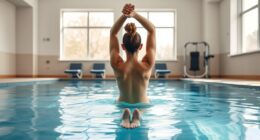While snorkeling, make the most of natural light by staying within 10-15 feet of the surface during midday for vibrant views of coral reefs and marine life. Use a waterproof camera with proper settings, like increased exposure, and consider employing red filters to restore colors. Keep your movements slow and steady to avoid disturbing underwater habitats and guarantee clear, sharp shots. If you continue exploring, you’ll discover even more tips for capturing stunning marine scenes.
Key Takeaways
- Maintain proper buoyancy and gentle movements to stay afloat and minimize disturbance to marine life.
- Use natural sunlight at midday within 10-15 feet depth for optimal illumination of underwater features.
- Keep your body relaxed and steady to enhance stability and reduce motion blur in photos.
- Incorporate interesting habitat elements like coral branches or schools of fish in your composition.
- Adjust camera exposure settings and utilize red filters to capture vibrant, well-lit underwater scenes.

Snorkeling offers a fantastic way to explore the vibrant underwater world without diving deep. As you float above the water’s surface, you get a close-up view of coral reef habitats teeming with life. These ecosystems are vital to marine biodiversity, providing shelter and nourishment for countless species. When you’re in the water, your perspective is unique—you can observe the intricate structures of corals and the colorful fish that dart among them. To make the most of your experience, mastering underwater photography techniques can be incredibly rewarding. With a few simple tips, you’ll capture stunning images that reveal the beauty below the surface, even with a basic waterproof camera.
First, understanding underwater lighting is key. Sunlight filters differently through water, causing colors to fade at depth. To combat this, try to stay within a shallow range where natural light is abundant—usually within 10 to 15 feet. When taking photos, shoot during midday when the sun is overhead for the brightest, most vibrant results. Adjust your camera settings to maximize exposure, and consider using a red filter to restore the true colors of corals and marine life. Composition also plays a vital role. Keep your shots steady by floating gently rather than hovering or rushing, and frame your subject to include interesting elements of the coral reef habitat, like a school of fish or a twisting coral branch.
Additionally, pay attention to your buoyancy and movement. Proper buoyancy control keeps you from damaging delicate coral structures while allowing you to remain stable for clearer shots. Practice slow, deliberate movements to avoid disturbing the marine environment and to reduce motion blur in your photos. When you spot a vibrant scene or an unusual marine creature, take your time to compose multiple shots from different angles. Often, patience pays off with sharper, more compelling images. Improving your buoyancy control can significantly enhance both your safety and photography results underwater.
Frequently Asked Questions
What Is the Best Time of Day for Snorkeling and Marine Exploration?
The best timing for snorkeling and marine exploration is early morning or late afternoon. During these times, you’ll experience peak visibility because the water is calmer and sunlight penetrates more effectively. Avoid midday when the sun is high, as glare reduces visibility and makes it harder to see marine life. By choosing these ideal times, you’ll enjoy clearer views and a more vibrant underwater experience.
How Can I Prevent Water From Entering My Snorkeling Mask?
To prevent water from entering your snorkeling mask, make sure it fits snugly but comfortably. Use mask sealant or a silicone grease on the skirt to reduce water leakage. To avoid mask fogging, rinse it with fresh water and apply a defogging solution before diving. Check for cracks or tears in the mask. Practice proper fitting and maintenance, and you’ll enjoy clearer, leak-free snorkeling experiences.
Are There Specific Safety Tips for Exploring Shallow Waters?
Sure, because exploring shallow waters is just like a walk in the park—except with unpredictable currents and curious marine life habitats. Always stay aware of shallow water currents to avoid getting swept away, and keep a safe distance from delicate marine habitats. Use a snorkeling buddy for extra safety, wear appropriate gear, and stay calm if you encounter wildlife. After all, adventure is safest when you’re prepared!
What Equipment Is Essential for Light Marine Exploration?
You’ll want essential equipment like a mask and snorkel to see marine flora and aquatic fauna clearly. A lightweight wetsuit offers protection, while fins help you move effortlessly. Use a waterproof camera or underwater phone case to capture marine life. Don’t forget a dive light for better visibility in dim areas, and a small net or container to gently observe marine flora and fauna without harm. Safety always comes first.
How Do Weather Conditions Affect Snorkeling Visibility?
Weather conditions markedly sway your snorkeling visibility. Strong, swift underwater currents can carry away your clarity, making sighting marine life tricky. When water temperatures tumble, visibility dims as algae bloom or water becomes murky. Calm, clear days with gentle breezes boost your chances of seeing splendid sea creatures. Keep an eye on weather forecasts, and choose days when the water’s warm and the weather’s welcoming for a wonderful underwater adventure.
Conclusion
So, seize the sensation of shimmering seas and shimmering sights. Snorkeling offers sensational sights and serene solitude, stirring your spirit and sparking your sense of discovery. Slip into the saltwater, stay steady, and savor the splendors beneath the surface. With a little courage and curiosity, you’ll uncover underwater wonders that will wow and wow again. Dive, discover, delight—your light marine adventure awaits, promising pure pleasure with every peaceful plunge.



